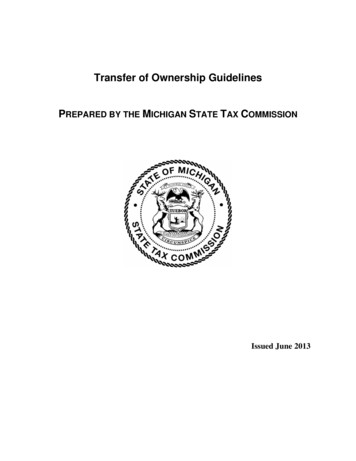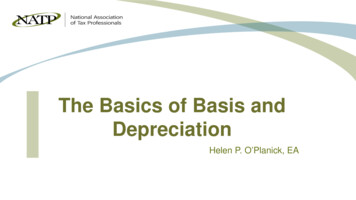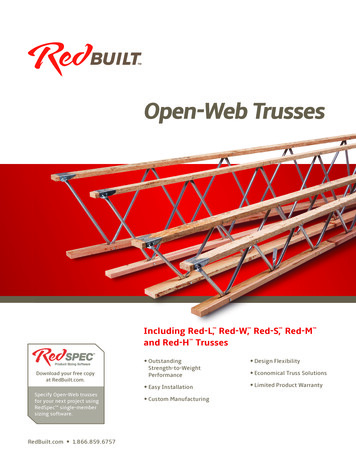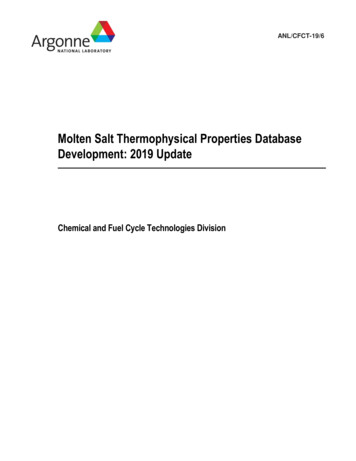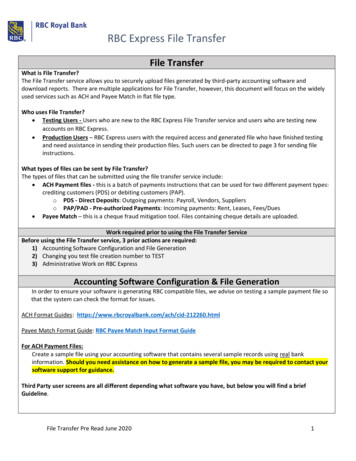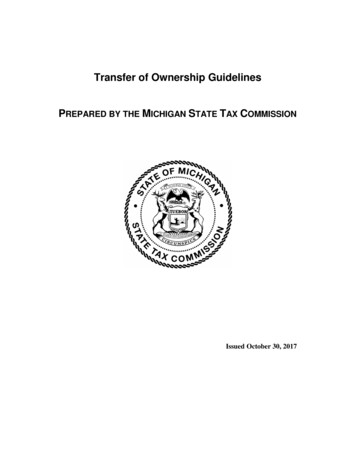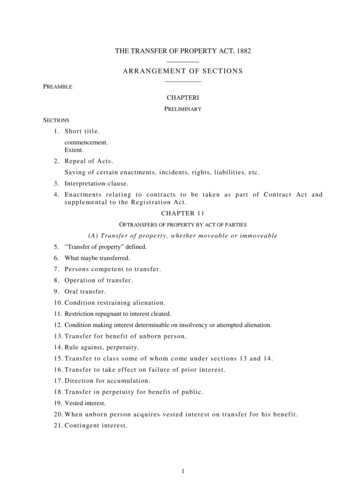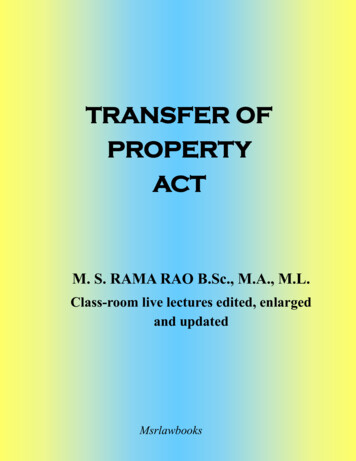
Transcription
TRANSFER OFPROPERTYACTM. S. RAMA RAO B.Sc., M.A., M.L.Class-room live lectures edited, enlargedand updatedMsrlawbooks
TRANSFER OF PROPERTY1929Page1By M S RAMA RAO B.Sc.,M.A.,M.L.,msrlawbooks Transfer of property
INTRODUCTIONTransfer of Property is the most difficult subject, next only tojurisprudence. The reason is that it deals with certain doctrineshaving their Origin in the Common Law of England, some totallyalien to the Indian Concepts.Page2The Transfer of Property Act 1882, was amended substantiallyin 1929. The student must lend much attention to the doctrinesenshrined in the Act. An. attempt is made to present the subject withas much lucidity as possible. Case law is given its due place. Noattempt is made either to exhaustively deal with the subject or tointensively probe into each doctrine.Wherever it is found essential, a comparative picture is drawncomparing the Indian Law with the English. Some topics especiallyon Gifts, Leases & Exchange. are too simple and easy to understand.Though the preliminary aspects relating to transfer, sale & Mortgage,are simple the various doctrines in their ramification present themselves to be formidable. A careful study should be made to understand the doctrines of "Rule against Perpetuities", of 'Election', of,Accumulation, of Acceleration, of "Ostensible Owner", of 'LisPendens', of "Feeding the Estoppel" of "Part Performance","Marshaling & Contribution", of Subrogation, of Tacking etc.Illustrations should be analyzed.msrlawbooks Transfer of property
QUESTIONS BANK1.(1) Explain 'Transfer of Property'(2)' Absolute restraint on Transfer of Property is voidDiscuss.2.' Property of any kind may be transferred' Discuss.3.(1) Explain the principles that govern transfers toUnborn persons.(2) Write a note on Contingent interest.4.(1) Discuss the doctrine of 'Rule against prepetuity'. (2) Statethe English Law of the doctrine.5.Distinguish conditions precedent from conditionssubsequent.6.Write an essay on the 'doctrine of Election'.7.Discuss the law relating to Ostensible Owner.8.Discuss the doctrine of Lis Pendens.9.State & explain the principle of performance.Write Short Notes on :(a) Immovable Property(b) Attestation (c) Actionable Claim (d) Constructive notice(e) Direction for accumulation (f) Doctrine of Acceleration(g) Fraudulent Transfers.11. Explain: i) Covenants annexed to land, ii) Feedingthe Estoppel, iii) Improvement made by bonafide holderwith defective title.10.12. i) Define Sale.ii) What are the right and the liabilities ofthe Vendor & the Vendee ?13.Explain the characteristic features ofi) Simple Mortgage ii) Mort gage by conditionalsale iii) Usufructuary Mortgage iv) English Mortgage v)Mortgage by deposit of title deed vi) Anomalous Mortgage.14. What are the rights & liabilities of a mortgagee inpossession.15. ' Once a mortgage always a mortgage' Explain.Page316. Discuss the doctrines of' Marshaling' &'Contribution'. Illustrate.17. Explain: i) Subrogation ii) Tacking iii) 'Redeemup foreclose down'.18. What is a lease? How is a lease terminated?Distinguishmsrlawbooks Transfer of property
between a lease & a licence.19. What are the rights & the liabilities of a lessor & alessee?Define'Gift'.Explain i) Onerous Gift, ii) Universaldonee.iii) Donatio mortis causa, iv) Exchange.21. State the facts & the decision in (i) Marshall V20.Green(ii) Allcard V Skinner (iii) Tagore V Tagore (iv) Cooper VCooper (v) Laxman V Kalicharan (vi) Bellamy V Sabine(vii) Ramsden V Dyson (viii) Maddison V Alderson(ix)TulkVMoxhay (x) Aldrich V CooperTABLE OF CASESChapters1.Preliminary Topics 1.2 AttestationShamu V. Abdul Khadar1.3. Immovable PropertyMarshall V. GreenHolland V. Hodgson1.4. Constructive NoticeThilak Devilal 's Case1.5. Spes SuccessionsAmrit Narayan V GayaAllcard V walker1.6. Actionable ClaimsColonial B ank V WhinneyMachiran V. Issham Chander2.Transfer of any kindNagaratnamma V. RamiahAchal Ram V. Kasim3.Gift1. RequisitesPage4Allcard V Skinner4.Lease2. Lease & Licensemsrlawbooks Transfer of property
Clubwala V Hussians3. Rights & DutiesSpenser's CaseKatyayini devi5.Unborn PersonTagore V TagoreSopherVA.G. of Bengal6.PrepetuityWhitbyV MitchellCadellV Palmar7.'ConditionsEdwards V Hammand8.ElectionsCooper V Cooper9.Ostensible OwnerLaxman N Kalicharan2. Feeding the EstoppelSmith VOborneSunderlalVGhisa10.Jumma Mas] id V DeviahLisPendensBellamy VSabine11.Bonafide holder1. Bonafide holderRamsden V DysonNarayanarao V BasvarayappaForbeVRalliPage52. Fraudulent TransferTwyne's CaseMusahar Sahu V Hakim12.Natha V DhunbhaajiPart PerformanceMaddison V Aldersonmsrlawbooks Transfer of property
Ram Gopal V Custodian13.14.Technicians StudioConvenant AnnexedTulkV.MoxhayDyson V. ForsterMortgage4. UnsfructuarySubbannaV. Nariah5. AnomalousNarasingh Pratap V. Yagoob'7. RedemptionShere Khan V. Swami Dayal8. Doctrine of marshallingAldrich V. CooperPage616. Miscellaneous 2.Accelerationlull V JonesUnderwood v. Ward4. Accumulation Thalluson V. Wood FordBerry V. Greenmsrlawbooks Transfer of property
CONTENTSChaptersPagesIntroductionSyllabusQuestions BankTable of Cases1. Preliminary Topics1. Transfer of Property92. Attestation3. Immovable Property4. Constructive Notice5. Spes Successions6. Actionable Claims7. Exchange8. Charge2. Transfer of1. Property of any kind143. Gift1. Requisites162. Revocation3. Onerous Gift4. Universal Donee4. Lease1. Lease182. Lease & Licence Distinguished3. Rights & Duties of Lessor & Lessee4. Termination5. Unborn Person236. Perpetuity247. Conditions Precedent & Subsequent268. Doctrine of Election289. Ostensible OwnerPage71. Ostensible (Benami)302. Feeding the Estoppel10. Lis Pendensmsrlawbooks 32Transfer of property
11. Bonafide Holder1. Improvement by Bonafide Holder332, Fraudulent Transfer12. Part Performance3513. Convenant Annexed to Land3714. Sale1. Sale- defined392. Rights & Duties of Seller3. Rights & Duties of Buyer15. Mortgage411. Definition-kinds2. Simple Mortgage2.2 Equitable Mortgage3. Mortgage by Conditional Sale414. Usufructuary425. English6. Anomalous437. Redemption438. Doctrine of Marshaling and Contribution449. Subrogation4610. Tacking11. Redeem up, foreclose down12. Rights and Liabilities of4747Mortgagee in Possession4813. Substituted Security14. Doctrine of Consolidation16. Miscellaneous48491. Rule Against Inalienability502. Doctrine of Acceleration3. ApportionmentPage84. Rule against Accumulationmsrlawbooks Transfer of property
CHAPTER 1PRELIMINARY TOPICSCh. 1-1 Transfer of Property :Sn.5 of Transfer of Property. Act defines Transfer ofProperty'. It means an act by which a living person conveys propertyin present or in future to one or more living persons, or to himself, orto himself and to one or more other living persons.Living person includes a Company, Association or body ofindividuals. The T.P. Act deals with sale, mortgage, gift, lease andexchange. Hence, abandonment is not a transfer. Partition is not atransfer. Transfer to himself and others: This is possible in case oftrust. Future property can be transferred (subject to Sn.6.).The persons must be competent to make a contract. The transfer of property passes all the interests of the transferor and the legalincidents, to the transferee.Registration, under the Registration Act is compulsory if thevalue of. the immovable property is worth Rs.100/- and above.Ch.1-2 Attestation:The T.P. Act defines attestation in Sn.3. Attesting in respectof an instrument means that the documents must be attested by twoor more witnesses each of whom has seen the executant sign or affixhis mark to the document. Further each of them must have signedthe instrument in the presence of the executant.The attestors must have animus attestandi (intention ofattesting). It is not necessary that more than one should be present atthe same time. Law also does not prescribe any particular form ofattestation. The usual procedure is that the attestors must sign withaddress and date.The Privy Council in Shamu Vs. Abdul Khandir, resolved thecontroversy whether the attestors should have actually seen heexecution or not, of the document. It held that the attestors who signthe document must have actually seen the document executed. Thiswas accepted in Sn.3. but it is given retrospective effect.In English law attestors should all be present at the sametime and must have seen the execution. But it is not so, accordingto Indian Law.Page9Attestors should be a sui juris (person legally capable) Eventhumb impression is allowed.Attestation does not mean that attestors have notice of thecontents of the document. But attestation estops from denying thefactum of execution. They vouch to the execution, not to contents.msrlawbooks Transfer of property
Ch.1-3 Immovable Property:The Transfer of Property Act deals with various transfersrelating to immovable property. S.3(2) says, Immovable Property doesnot include standing timber , growing corps or grass. The GeneralClasses Act says, Immovable Property includes lands, benefits thatarise out of land and things attached to the earth. 'Attached to theearth' means rooted to the earth i .e., trees, shrubs etc., imbedded inthe earth i .e., walls or buildings, attached to what is so embedded.Further right to receive future rent is Immovable Property.Marshall V Green: Sale of trees to be cut and taken away.Held: sale was not for Immovable Property, if the intention of theparties is that the trees should have further nutriment from the land,then it is Immovable Property otherwise not.In English Law, there is the doctrine of fixtures. Whether achattel is resetting merely, by is weight on the floor, it is notimmovable.In Holland V. Hodgson : a mortgage of a mill was made. Held:Certain looms attached to the stone of the mill, was also covered bythe mortgage.Ch. 1-4 Constructive Notice.Section 3 defines notice. A notice may be actual or constructive. There is actual notice, when knowledge of a fact is broughtdirectly to the person concerned. It is constructive when there is apresumption of the knowledge of the fact. The following are itsdifferent kinds:i) knowledge is presumed when the party wilfully abstains frommaking enquiry.ii) Gross negligence of the party.iii) Registration:The privy council had held that registration was not aconstructive notice to subsequent transferees. (Thilak Devilal'sCase). This is now superseded by T.P.Act. Hence, registration of atransfer amounts to notice, from the date of registration.Page10iv) Possession as notice:If a person is actually in possession of a property, then theacquirer of the property is deemed to have notice of the title, if any,of the person in possession of the property.v) Notice to agent is treated as notice to the principal.The agent must have notice during the course of his business.msrlawbooks Transfer of property
If an agent fraudulently conceals the fact, then there is notice to theprincipal. The principal should not be a privy to the fraud.Ch. 1-5 Spes Successionis:Means 'Chance of Succession'.S.6. of the T.P.Act provides that the chance of an heirsucceeding to an estate, or the chance of a relation obtaining alegacy of a Kinsman or such a mere possibility cannot betransferred.E.g.: The interest of a reversionary on the death of a Hinduwidow. In Amrit Narayana Vs. GayaSingh: 'A' hoping to succeed tothe property of his material grandfather B, sold to C, his such interest,during the life time of B. Subsequently B died. A sued for recoveryof property from C. Held: The sale was of a spes successions andtherefore void.Future interests in properties such as contingent interest orexecutory interest are transferable, as, here, the possibility is coupledwith an interest. Similar to spes successions, the possibilities of a likenature are:i) Chance of a person deriving income from scavengingwork, which he expects to get in future.ii) Right of a priest to a share in the offerings at the temple.There is a mere chance and hence inalienable.The leading case is Allcard V. Walker.Page11Ch. 1-6 Actionable Claim:Actionable claims include claims recognised by the courts togrant relief either(a) as to unsecured debts or (b) as to beneficialinterest in movable property not in possession (actual or constructive), whether present or future, conditional or contingent.This definition has solved many difficulties that had arisenearlier to 1900.The leading cases are:Colonial Bank V, Whinney and Muchiram V.Ishan Chandar.Sn.130 of the T.P.Act deals with the transfers of Actionableclaims. It says that a transfer of an actionable claim (whether with orwithout consideration) should be made only by the execution of aninstrument. Thereupon, all the rights and remedies of thetransferor become vested in the transferee, whether notice is givenor not. The transferee may sue or proceed in his own name withoutobtaining the consent of the transferor.msrlawbooks Transfer of property
Eg.: (a) A is the debtor and B is the creditor. B transfers thedebt to C. B then demand from A to pay; A pays without notice of thetransfer. The payment is valid. C cannot sue A for the debt. The debtis an actionable claim and may be transferred by B to C. But, C as.transferee has those rights and remedies as B. Hence, C cannot sue'A' for the debt.b) A has a life insurance policy. He assigns it to a Bank Bfor securing a loan. A dies. B is entitled to receive the amount ofthe policy. B can sue without the consent of A's executors.The following are actionable claims :i) Share in a Company ii) Mortgage debt iii) Claim to copyrightiv) Claim to mesne profits v) Mere right to sue.Ch. 1-7 Exchange: (T.P. Ac t Sn.111)When two persons mutually transfer the ownership of one thingfor the ownership of another, neither thing or both things money only,the transaction is called an 'Exchange'.Any such transfer can be made in the same manner as is done inrespect of sale.A partition of H.U.F. is not an Exchange. The parties toExchange are subject to the same rights & liabilities of the Vendorand the Vendee.Any defect in the title of the property exchanged, is to be setright by that party whose property had the defective title.A transfers his house to B and B transfers his wet land and payscash of Rs.5,000/- to A as consideration.This is an Exchange. If B had given money only, then it is not anExchange.Ch, 1-8 Charge : Sn.100Page12Where immovable property of a {person is by act of parties, (orby operation of law) made a security or the payment of money toanother, the latter person is said to hav a charge on the property.Conditions:i) The transaction should not amount to a mortgage.ii) All matters relating to the rights and liabilities of the partiesto the charge are governed by those applicable to a simplemortgage.(Sn.59 T.P.Act).iii) This will not apply to a trustee who makes a charge on thetrust-property.msrlawbooks Transfer of property
iv) Bonafide transferees without notice of the charge on theimmovable property are protected. A charge is an encumbrance onthe property.v) The formalities to be observed to create a charge are thesame as for a simple mortgage.In a charge, there is no transfer of any interest in the immovableproperty, as in a mortgage. There is creation of a right of payment outof the property specified.Charge is less than a simple mortgage & cannot take priorityover it. .Page13It is a jus ad rem, and not jus in rem. There is no personalcovenant to pay ; there is merely an obligation on the property forpayment.A charge cannot bind a bonafide purchaser for value who hadno notice of the charge.msrlawbooks Transfer of property
CHAPTER2TRANSFER OF ANY KIND OF PROPERTYCh. 2 'Property of any kind may be transferred'.Explained.Section 6 of the T.P.Act provides for the exceptions to the rulethat property of any kind may be transferred. The exceptions are:a) Spes Successionis.b) Transfer of Right of Re-entry and Easement.c) Religious Office.d) Serving of Inams.e) Maintenance Right.f) Mere right to sue.g) Public Office, stipends and pensions,h) Illegal transfers.Explanation:a) Spes Successions means 'chance of succession' such an interest cannot be transferred. [Refer Ch.1-5]b) Right of re-entry as easement:A lessor may reserve to himself a right of re-entry on breach ofa convenant by his, lessee. This right cannot be transferred apart fromthe estate. A leases his land blackcare to B on Rs.1,000/- per annumwith the right of re-entry on default by lessee. B commits default. Ahas a right of re-entry. This right cannot be transferred by itself toanother person.An easementory right of way cannot be transferred by itselfwithout the transfer of the dominant heritage.c) Religious Office, cannot be transferredPage14d) Serving of Inams:msrlawbooks Transfer of property
An interest in property restricted in its enjoyment to the ownerpersonally cannot be transferred by him. Service of Inams is anexample.A was entitled to an Inams, for his 'Swastivachakam'service at a temple. 'A's successor x sold this interest to B. Held: Thatthe alienation was void. Similarly, a religious office also cannot betransferred.Page15e) Right to future maintenance in whatsoever manner arising,secured or determined, cannot be transferred.W, the wife of H was receiving a maintenance of Rs.3,000/- peryear. W is not entitled to recover her maintenance for the next year inadvance. But, if H has defaulted in payment she has a right to recoverthe arrears. This right can be transferred by her to C. Hence, a pastmaintenance can be transferred but not the future right tomaintenance.f) A mere right to sue cannot be transferred.A has right to recover damages from B for a tortious liability(e.g. Assault), this right cannot be transferred as it is a mere right tosue. Similarly a mere right to sue for breach of contract, cannot betransferred.g)Pensions, stipends, public office etc. cannot betransferred,h) Illegal Transfers:No transfer can be made if it is i) havingunlawful object or consideration, ii) opposed tothe nature of interest effected, iii) to a legallydisqualified transferee.Transfer of property to future illicit cohabitation is void.Transfers made for past cohabitation are not bad as the past cohabitation was not the 'object'. In Nagaratnamma Vs. Ramaiah the supremeCourt upheld such a transfer.'Champertous transfer' by itself is not void in India. Achal RamVs. Kasim. A moiety created to person in a civil suit was held asgood, as it is not opposed to public policy.msrlawbooks Transfer of property
CHAPTER 3GIFTCh. 3-1 Requisites of a valid gift:Section 122 of T.P.Act defines a gift. 'It is the transfer ofcertain existing movable or immovable property made voluntarily andwithout consideration and accepted by or on behalf of the donee'.The person who makes the gift is the donor.The donee must accept the gift:a) during the life time of the donor andb) While the donor is still capable of giving the property gifted.But if the donee dies before acceptance the gift is void.Gift of movable property may be registered or may be effectedby delivery. However gift of immovable property of any valuerequires registration under sections 17 (a) of the Registration Act. Itmust be signed by the donor and must be attested by two witnesses.Gift to God Almighty may be oral or may be in writing or may beregistered.A makes a gift of his jewels to B. This may be done by delivery.A makes a gift of a piece of land worth Rs.50/-. This is to beregistered.The property must be existing at the time of the gift. A gift offuture property is void. When a gift is made to several persons andone or more donees does not accept, then it is void respect of thosewho do not accept.Ch. 3-2 Revocation of gift:(i) Conditional gifts:Page16The fundamental rule is that 'A resumable gift is not a giftat all.' A gift once given cannot be revoked at the mere will ofthe donor; such a gift if made, is void ab initio. But, a conditionalgift is void.A conditional gift which attaches a condition subsequentis valid if the condition is not vague or illegal or immoral oropposed to public policy or impossible of performance. Henceconditional gifts may be made.Ex.: A gifts to B a plot of land, reserving to himself with theconsent of B, to take back the plot if B or his descendants die beforeA. B dies without any descendants during A's life time. The conditionis valid and A may take back the plot.b) A make a gift to C, a concubine, for her continued relationship with the donor. The condition is immoral therefore gift is void.c) A gives Rs. 1 lakh to B reserving to himself with B's consent,msrlawbooks Transfer of property
the right to take Rs. 25,000 at his pleasure. Gift is valid uptoRs.75,000/- only. It is void in respect of Rs.25,000/-.(ii) Gift made under coercion, fraud undue influence or misrepresentation may be revoked by the donor.Protection of Transferees: Transferees who take theproperty for consideration and without notice are protectedagainst any prejudice that may result due to revocation bythe donor. The leading case is:Allcard Vs. SkinnerA, a sister executed a gift to S, the lady superior under undueinfluence. Later A sued to set aside the gift. A would have won butthere was too much of delay is suing. Hence, her claim was dismissed.Ch. 3-3 Onerous Gift :Section 127 of T.P.Act deals with onerous gift. It means asingle transfer made to the donee but some of the properties giftedare burdened by obligations. The donee must take the entire gift. If heaccepts only to take those which are without obligations, then the giftis void. But if the gift is in two or more separate and distincttransactions, the donee may select at his liberty and refuse thosewhich are not beneficial to him.A minor may repudiate the onerous gift after attainingmajority. Effect of Onerous gift: The donee is liable to the extentof the total gifted property in his hands.Ch. 3-4 Universal Donee:Here a gift of the entire property of the donor is made to adonee. The donee is liable for all the debts, dues and liabilities of thedonor at the time of the gift. This liability extends to the extent ofthe property in the hands of the donee. Such a person who takes theentire rights and liabilities is called a universal donee. Property meanshere movable and immovable. If A makes a gift of his immovablesonly and not movables to B, B is not a universal donee.The universal donee is liable only to the extent of theimmovable and movable property comprised in the gift.The liability is with reference to the tune of gift by the donor,that is universal donee is not liable for debts & liabilities incurredby the donor after the universal gift is made.Page17Eg. : A gifts in one transaction, 200 shares of X & Co. aprosperous company and also 100 shares of Y & Co. a company indifficulties. Heavy calls are expected from Y & Co. A may take theentire gift. He is a onerous donee. He cannot take the gift of theshares of X & Co. only.msrlawbooks Transfer of property
CHAPTER 4LEASECh. 4-1 Lease :Sn.105 of the T.P.Act defines a lease. A lease of immovableproperty is defined as the transfer of the right to enjoy such propertymade for a certain time, in consideration of a price paid or promised. The consideration may be a fixed amount or a share ofcrops or serving of any other thing to be rendered periodically orotherwise. Lease may be oral or in writing.If the lease is for one year or above then it must be in writingand must be registered.Leases for lesser period may be oral or in writing.Registration is optional. Delivery of possession is necessary, in boththe circumstances.Ch. 4-2 Distinction between Lease and Licence:LEASELICENCEa) A lease creates an interest in theproperty.But a licence does not ere-ate any interest in theproperty. It is a permissionto do an unlawful act onthe immovable propertyi.e, would have been unlaw-ful had there been nolicence.b) Lessee gets exclusive possessionof immovable property.A licensee does not getsuch a right.A licence is not transfer-able.c) A lease is assignableA licence is revocable. Ae) A lessee can bring an actionlicence cannot sue in hisfor trespass.own name.Page18d) A lease is not revocablemsrlawbooks Transfer of property
f) According to T.P. Act, lease is tobe registered if it is for one year orabove.But for licence registrationis not necessary.g) A lease-hold creates aheritable interest.A licence does not createsuch an interest. It is determined by the death of thegrantor or of the licencee.In Clubvala Vs. Russian it was pointed out that 'exclusivenessof possession' is a quality that distinguishes the lease from a licence.Effect of non-registration: If a document of lease which is to beregistered has not been registered at all, the position was controversial due to a number of High Court decisions. To put an end to thisthe T.P.Act was amended in 1920. The Privy Council had held thatnon-registration would render the lease void. According to the amendment where there is no registration the doctrine of part performancemay be invoked to protect the position of the lessee. An unregisteredlease may be admitted in evidence only to show that the possession isunder a lease. This is under section 27(a) of Specific Relief Act.Ch. 4-3 Rights and Duties of the Lessor and Lessee.The T.P. Act under section 108 provides for the rights andliabilities of the lessor and lessee:i) The rights and liabilities of the lessor.a) The lessor should disclose any material or latent defects inthe property leased.b) The lessor must put the lessee in possession of the property.c) There is a covenant for quite enjoyment of the property if thelessee is paying the rent during the period of the lease.Page19ii) Rights and liabilities of the lessee.a) Lessee's right to accretions if there is any accretion to thebenefit of the property. The lessee is entitled to such accretions. Thismsrlawbooks Transfer of property
is of course subject to the law relating to alluvion. Hence adjoiningwaste land brought under cultivation is not accretion.b) Voidable lease: If the material part of the leased property isdestroyed (partially or completely) by fire, tampest or floods orviolence or by the enemy, the lease is voidable at the opinion of thelessee. Of course, the lessee should not be the cause causans, for thedestruction of the property.Ex.: A, was a lessee running a shop. But due to mob violencethe building was set on fire. The owner claims the value of the building from A. Held: Owner not entitled. A may avoid the lease if he soprefers.c) Right to Sub-lease :Unless prohibited by the lessor under the lease deed, the lesseeis entitled to sub-lease.d) Right to fixtures:Anything affixed to the land becomes part of the land. Thelessee is entitled to such fixtures.e) Right to repairs:Lessee may, by giving reasonable notice to the lessor, make therepairs if the lessor has neglected it. The lessee may deduct suchexpenses from the rent or he may recover from lessor.f) Payment on behalf of lessor :If the lessor has neglected to make payments (House tax etc),the lessee has a right to pay and get it reimbursed from the lessor.g) Right to ingress :The lessee has free ingress(Right to enter) & Egress & to carryany crops grown by the lessee when the lease is terminated.h) Duty to restore possession:Page20The lessee is bound to restore the property to the lessor inmsrlawbooks Transfer of property
good condition i.e., as the property was at the time of the lease(subject to the normal wear and tear). However if the defect is causedby the lessee he should not use the property for a purpose differentfrom a purpose agreed upon. He should not fell timber, pull down ordamage buildings or commit any other destructive or injurious actsthereto.i) The lessee should not erect permanent structures on the property except for agricultural purposes.j) The lessee is bound to pay the rent as agreed upon.Leading cases are :i) Spenser's Case.ii) Katyayini devi Vs. Udaya Kumar.Ch. 4-4 Termination of lease:A lease is terminated:a) by efflux of time:If the lease is for a fixed period e.g. for 2 years, the lease terminates on the expiry of 2 years.b) On the happening of an event, e.g.The lease is for 20 years or ends on the death of the lesseewhichever happens first. Here the lease terminates on the expiry of20 years or on the death of the Lessee.c) Merger:When the lessor and lessee become one. This happens when thelessee buys the lease property; of course he must buy the entireinterest in the property.d) Surrender:Page21A lease is terminated by surrender. It consists of yielding up ofthe term by the lessee to the lessor, and of delivery of possession tothe lessor, and, acceptance by the lessor. Hence, mutual agreement isessential for surrender.msrlawbooks Transfer of property
e) Implied Surrender:This happens when the lessor accepts a new lease, with different terms and conditions, during the continuance of the existing lease.Here, there is the implied surrender of the original lease. (GeminiMohan V/s. Devendra)f) Forfeiture:By forfeiture the lease is terminated. Three circumstances areprovided:(i) There is forfeiture, when the lessee breaks an express condition. The lessor sho.uld serve his notice to the lessee to quit.Page22(ii) There is forfeiture, when the lessee sets up the title to theproperty in a third person or in himself. Notice by lessor to quit isessential.(iii) When there is a provision in the lease, that on the lesseebecoming insolvent, the lessor may re-enter, the lease may be terminated by giving notice to the lessee.In the above three circumstances, acceptance of rent by lessor,amounts to waiver or forfeiture.g) Notice to quit:Notice to quit or to terminate the lease should be given by thelessor to the lessee.If after giving notice the lessor accepts rents, it amounts to waiverof notice to quit.A, the lessor gives B, the lessee to quit. The period of noticeexpires. A accepts rents from B. The notice is waived.msrlawbook
the English Law of the doctrine. 5. Distinguish conditions precedent from conditions subsequent. 6. Write an essay on the 'doctrine of Election'. 7. Discuss the law relating to Ostensible Owner. 8. Discuss the doctrine of Lis Pendens. 9. State & explain the principle of performance. 10. Write Short Notes on:(a) Immovable Property


